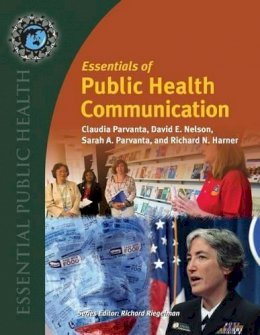
Stock image for illustration purposes only - book cover, edition or condition may vary.
Essentials of Public Health Communication
Claudia Parvanta
€ 205.74
FREE Delivery in Ireland
Description for Essentials of Public Health Communication
Paperback. Health Behavior, Education, & Promotion Num Pages: 416 pages, black & white illustrations. BIC Classification: MBN. Category: (U) Tertiary Education (US: College). Dimension: 275 x 216 x 22. Weight in Grams: 1032.
The field of communications is increasingly recognized as a powerful tool in addressing the world's most imperative public health challenges. Effective communication in health campaigns can inform, empower, or persuade individuals to adopt healthier lifestyles as well as foster public debate and policy change.Featuring a full chapter on informatics, this book is devoted to the competencies in health communication and informatics recommended by the Association of Schools of Public Health. With chapter contributions from some of the leading experts in public health informatics and epidemiology, health communication and evaluation, Essentials of Public Health Communications introduces concepts and examples that will prepare students to enter a local health department, community organization or government agency, and contribute to health communication research, patient counseling, materials design, program management and media relations. Written specifically for student use, this book presumes no prior knowledge of the health communication or the informatics fields. Concepts are presented in clear, jargon free language, with terms defined throughout.Key Features:•Rather than simply presenting theories and cases, this text emphasizes the framework and methods, breaking down complex tasks into steps for mastery. •Simplifies key concepts in public health informatics, and how data are transformed into useful information and effective presentations. •Examines how health communication is actively being used by the leading public health agencies and organizations today. •A companion website provides a complete package of instructor resources including sample syllabi and curriculum guides for two semesters of instruction, as well as small scale research projects. •Includes suggested health communication projects that can be implemented at an academic institution, or small scale community level, to enable hands-on learning. Looking for more real-life evidence? Check out Cases , 5, , , 5, , amp 8-2 in Essential Case Studies in Public Health, Putting Public Health into Practice.
Product Details
Format
Paperback
Publication date
2010
Publisher
Jones and Bartlett Publishers, Inc
Number of pages
416
Condition
New
Number of Pages
416
Place of Publication
Sudbury, United States
ISBN
9780763771157
SKU
V9780763771157
Shipping Time
Usually ships in 15 to 20 working days
Ref
99-2
About Claudia Parvanta
Claudia Parvanta, PhD, is a Professor in the Department of Community and Family Health, College of Public Health, and Director of the Florida Prevention Research Center, at the University of South Florida, Tampa, since January 2017. Between July 2005 and December 2016, she led the Department of Behavioral and Social Sciences at the University of the Sciences in Philadelphia where her research emphasized health literacy and culturally competent health communication. From 2000 to 2005, Dr. Parvanta headed the Division of Health Communication at the Centers for Disease Control and Prevention (CDC). She was central to the agency’s communication response to the 9/11 attacks, anthrax, and SARS. Before government and academia, Dr. Parvanta worked at Porter Novelli, a global social issues communication company. Dr. Parvanta has designed, managed, or evaluated health and nutrition social marketing programs in more than 20 countries. She is the 2016 recipient of the Public Health Education and Health Promotion Division of APHA’s Distinguished Career Award. David E. Nelson, MD, MPH, currently heads up the National Cancer Institute’s Cancer Prevention Fellowship Program. He previously spearheaded efforts to develop the Health Information National Trends Survey (HINTS) for NCI, was the Acting Director of the Bureau of Smoking or Health, and directed the Behavioral Risk Factor Surveillance System (BRFSS) for the CDC. He co-edited Essentials of Public Health Communication (JBL, 2011); with B. Hesse' published Making Data Talk (Oxford University Press, 2009), and was the lead author (with Brownson, Parvanta, and Remington) of Communicating Public Health Information Effectively: A Guide for Practitioners (APHA, 2002). Normal0falsefalsefalseMicrosoftInternetExplorer4st1\:*{behavior:url(#ieooui) }/* Style Definitions */table.MsoNormalTable{mso-style-name:"Table Normal";mso-tstyle-rowband-size:0;mso-tstyle-colband-size:0;mso-style-noshow:yes;mso-style-parent:"";mso-padding-alt:0in 5.4pt 0in 5.4pt;mso-para-margin:0in;mso-para-margin-bottom:.0001pt;mso-pagination:widow-orphan;font-size:10.0pt;font-family:"Times New Roman";mso-ansi-language:#0400;mso-fareast-language:#0400;mso-bidi-language:#0400;}Sarah A. Parvanta, who received her MPH from the University of North Carolina in 2007, is now enrolled in a PhD program in Health Communication at the University of Pennsylvania's Annenberg School'for Communication. As a journalism student, Sarah Parvanta interned with the Health Unit of CNN in Atlanta, working for Dr. Sanjay Gupta, among others. She also spent two years supporting the Division of Cancer Prevention and Control at CDC, as a consultant. Despite these years of professional experience Sarah Parvanta brings a youthful perspective to the material, helping to ensure that the text makes sense not only to new learners, but also to her generation of students. She is the co-author for the chapters on theory and new media, and she edited all the chapters in Section III.' Richard N. Harner, MD, is a clinical neurologist with more than three decades of clinical, teaching, and research experience. He directed the Neurology Department at the Graduate Hospital of the University of Pennsylvania and established the first center for the comprehensive medical and surgical treatment of epilepsy in the eastern United States. After 20 years, he moved to become Professor and Vice Chairman of Neurology at the Medical College of Pennsylvania, where he established a second epilepsy center and directed postgraduate neurology education. He has authored numerous scientific articles, does private consulting for the biotech and pharmaceutical industry, and teaches as an Adjunct Professor in the Neuroscience Program at the University of the Sciences in Philadelphia.
Reviews for Essentials of Public Health Communication
